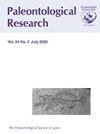Molluscan Faunal Changes from Brackish to Freshwater Deposits in the Lower Cretaceous Itsuki Formation of the Tetori Group, Japan
IF 0.6
4区 地球科学
Q3 PALEONTOLOGY
引用次数: 0
Abstract
Abstract. This paper focuses on the molluscan faunal changes in the nonmarine deposits of the Lower Cretaceous (Barremian) Itsuki Formation of the Tetori Group, central Japan. In the lower part of the Itsuki Formation, the transition from brackish to freshwater environments is recognized by lithofacies, sedimentary structures, and fossil indices of molluscs and plant remains. The molluscan assemblages include eleven gastropod species and six bivalve species, and one new gastropod species, Probaicalia okurai sp. nov., is described. The brackish habitats in the delta-front were dominated by Myrene tetoriensis, which usually formed shell beds. The newly founded freshwater habitats on the fluvial environments were populated by Campeloma onogoense and Sphaerium coreanicum as pioneer immigrants. With the development of the fluvial floodplain, a variety of aquatic and semiaquatic microenvironments formed, thereby providing various habitats suitable for small gastropods.日本鸟取群下白垩世Itsuki组从咸淡水到淡水沉积物的软体动物区系变化
摘要本文主要研究了日本中部哲多里群下白垩统(Barremian)Itsuki组非海洋沉积物中软体动物区系的变化。在Itsuki组的下部,岩相、沉积结构以及软体动物和植物遗骸的化石指数可以识别从微咸水环境到淡水环境的过渡。软体动物群落包括11种腹足类和6种双壳类,并描述了一个新的腹足类物种Probicalia okurai sp.nov。三角洲前缘的微咸水栖息地主要是特托里Myrene,通常形成贝壳床。在河流环境中新建立的淡水栖息地由Campeloma onogoense和Sphaerium coreanicum作为先驱移民居住。随着河流泛滥平原的发展,形成了各种水生和半水生微环境,从而为小型腹足类动物提供了各种适宜的栖息地。
本文章由计算机程序翻译,如有差异,请以英文原文为准。
求助全文
约1分钟内获得全文
求助全文
来源期刊

Paleontological Research
PALEONTOLOGY-
CiteScore
1.60
自引率
0.00%
发文量
47
审稿时长
>12 weeks
期刊介绍:
Paleonotological Research (PR) is a quarterly, peer-reviewed international journal, which focuses on original contributions primarily in the area of paleontology but also covering a wide range of allied sciences. It has been published since 1997 as a successor to the former journal Transactions and Proceedings of the Palaeontological Society of Japan. The emphasis of contributions will include global and local perspectives, and contents can cover all ages (Precambrian to the Quaternary, including the present time).
 求助内容:
求助内容: 应助结果提醒方式:
应助结果提醒方式:


